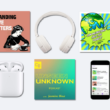Consumption and the desire to consume luxury goods and services have been part of our society for thousands of years. From silk garments in ancient China to ostrich feathers for the Egyptians to the Vanderbilts’ chateaus in America, luxury goods and services were always sought after by those who could afford them. Thorstein Veblen’s book “The Theory of the Leisure Class” captured social and economic perspectives of these extravagant lifestyles in 1899. He described luxury consumption activities as “conspicuous consumption” and “conspicuous leisure”.
In recent times, demand for luxury goods and services shows no sign of slowing. By 2021, personal luxury goods alone generated €283 billion for the global economy compared to just €116 billion at the beginning of the millennium.
50 Video Lessons | In-Depth Workbook | Templates | Support
The Ultimate Brand Building System is now open for registration. Enroll today to stand out in your market and create a future-proof brand!
Table of Contents
What exactly is luxury?
It is not surprising that luxury consumption and luxury branding has captured keen, sustained interest from both academia and industry. Numerous studies in this field have been done over the years, with scholars and practitioners weighing in their opinions. These often centered on attempts to define what exactly is luxury. Something trickier than it looks from the onset. Here are some of the conclusions.
- “Luxury is an elusive concept. There are as many definitions as there are authors” Kapferer & Bastien (2012).
- “The very essence of luxury is based on the inflation of its symbolic value over the functional value” (Olbertova, 2019).
- A group of scholars who focused on the concept of a necessity – luxury continuum define luxury as “anything that is desirable and more than necessary and ordinary” (Bearden & Etzel, 1982).
- The editor of Vogue magazine, Franca Sozzani, wrote that “luxury is intended as a byword for exclusiveness, research, experimentation, purity, class, discrete and richness” (Sozzani, 2011).
- Jean-Claude Biver of LVMH Group said at the Arab Luxury World Conference that “Luxury is whatever money cannot buy”.
- Perhaps the most appropriate description came from Jean-Marc Bellaiche, Antonella Mei-Pochtler and Dorit Hanisch who wrote in an article for Boston Consulting Group that “true luxury means different things to different people” (Bellaiche, Mei-Pochtler & Hanisch, 2010).
While there are varied opinions on what luxury really means, one can argue that all of them simply capture different aspects of the same topic. However, a key purpose in the search for a definitive view of any management construct has to be applicability. To date, the definitions of luxury are abstract and cannot be easily used by luxury brand managers. To achieve applicability, there is a need to filter the wide range of definitions down to its most granular and into a relatively simple, usable proposition. This proposition is likely encapsulated by a few fundamental thematic elements that can be observed from the majority of luxury brands – which is what we have set out to do in this research.
To uncover common thematic elements that define luxury, we conducted two studies.
Study 1 – Content Analysis
In Study 1, we gather detailed information from secondary sources for several luxury brands, analyzing their brand messages, key propositions, and market perceptions. Content analyses can help us spot common themes and value propositions that elevate these brands to their current luxury status.
To start off, familiar categories of luxury goods and services are first identified. These are (1) Automobiles (2) Fashion Goods (3) Watches (4) Furniture (5) Wellness Retreats (6) Hotels (7) Alcoholic Beverages and (8) Restaurants. Next, we randomly pick ten well-known brands in each category. We then analyze brand messages and market opinions for each of the 80 brands from publicly available sources, extracting key words and phrases used.
From here, we look for common themes that consistently emerge from the information extracted. For example, historical brand stories and technological innovations are frequent propositions from luxury automotive brands.

Similarly, most luxury fashion and watch brands are touted by rich origin stories. In addition, craftsmanship is often emphasized by fashion brands. At the same time, luxury watches play up on precision, attention to detail, and sometimes rarity.
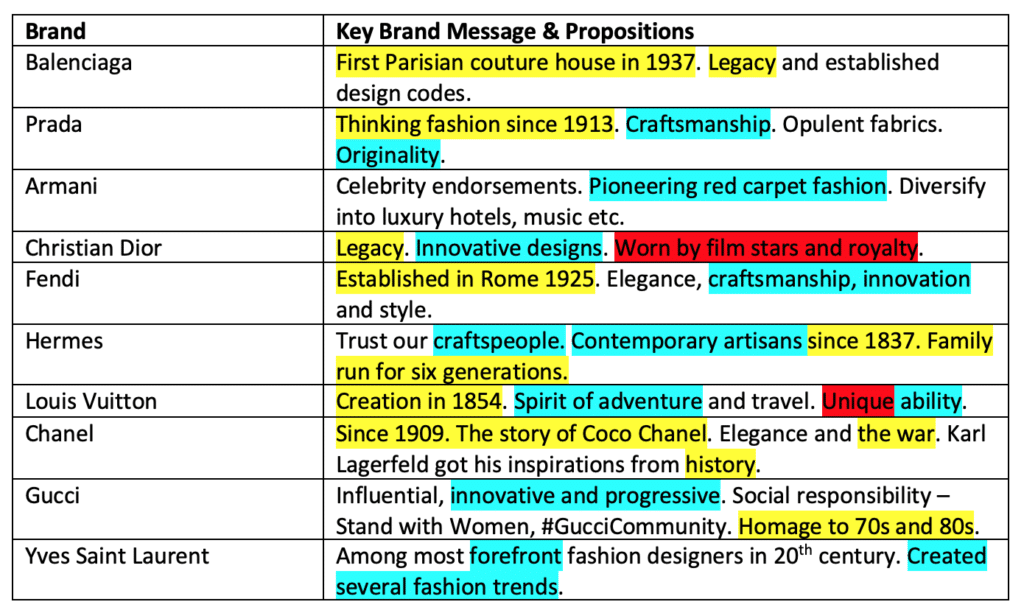
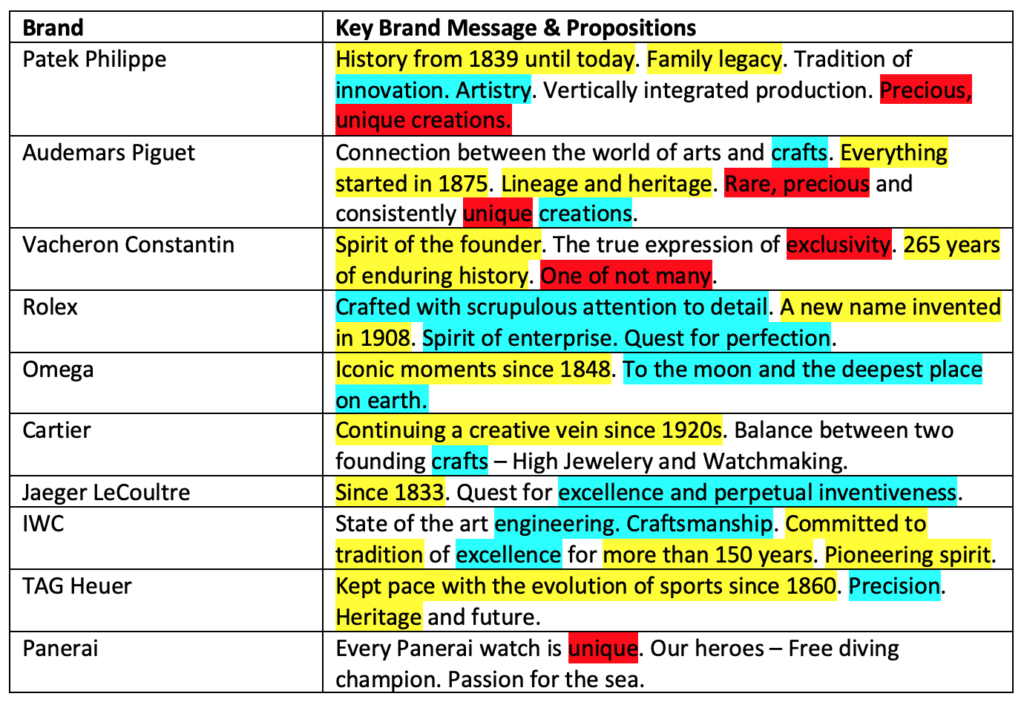
Unique pieces and artisanal workmanship are familiar words used to position luxury furniture brands.

Health/wellness getaways and hotels are known for their exquisite and superior locations. Many health & wellness brands have well-publicized, highly personalized services, while some luxury hotels are famous for their historical backgrounds.
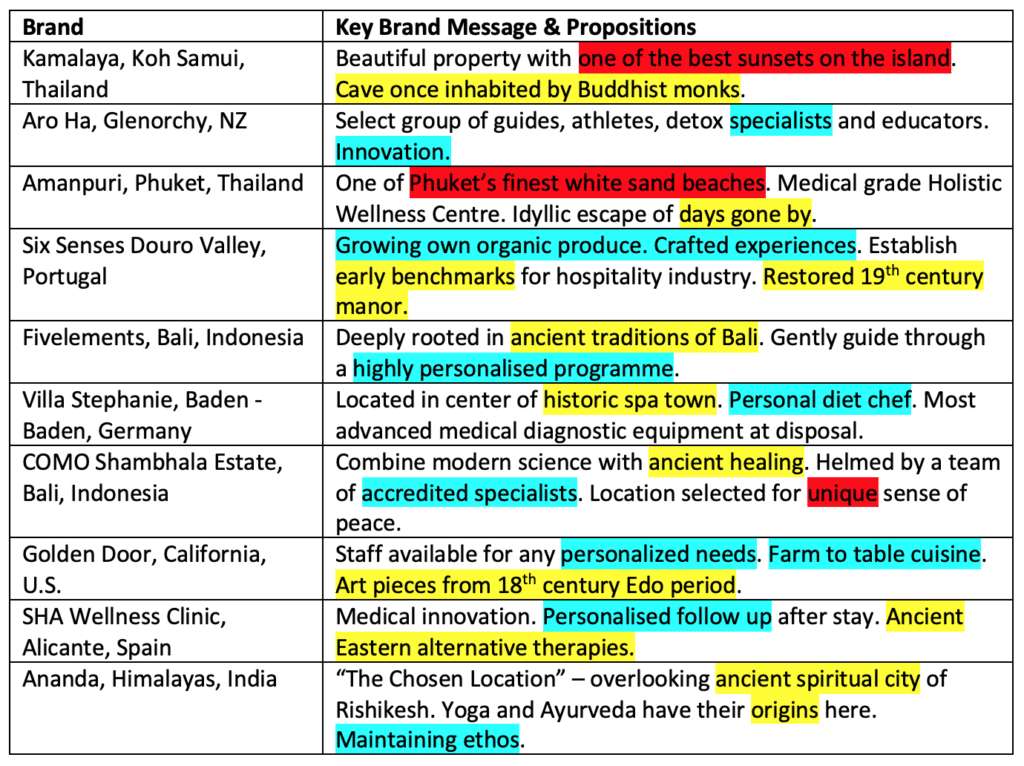
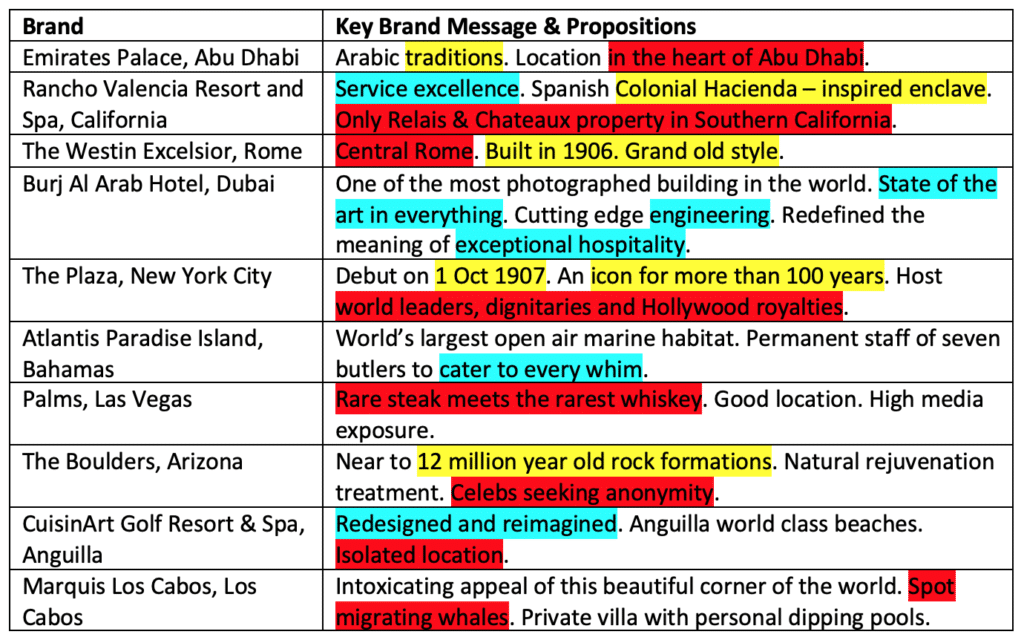
Interesting founding histories, long aging processes, rarity, and mastery in blending are common qualities among the group of luxury alcoholic beverages.
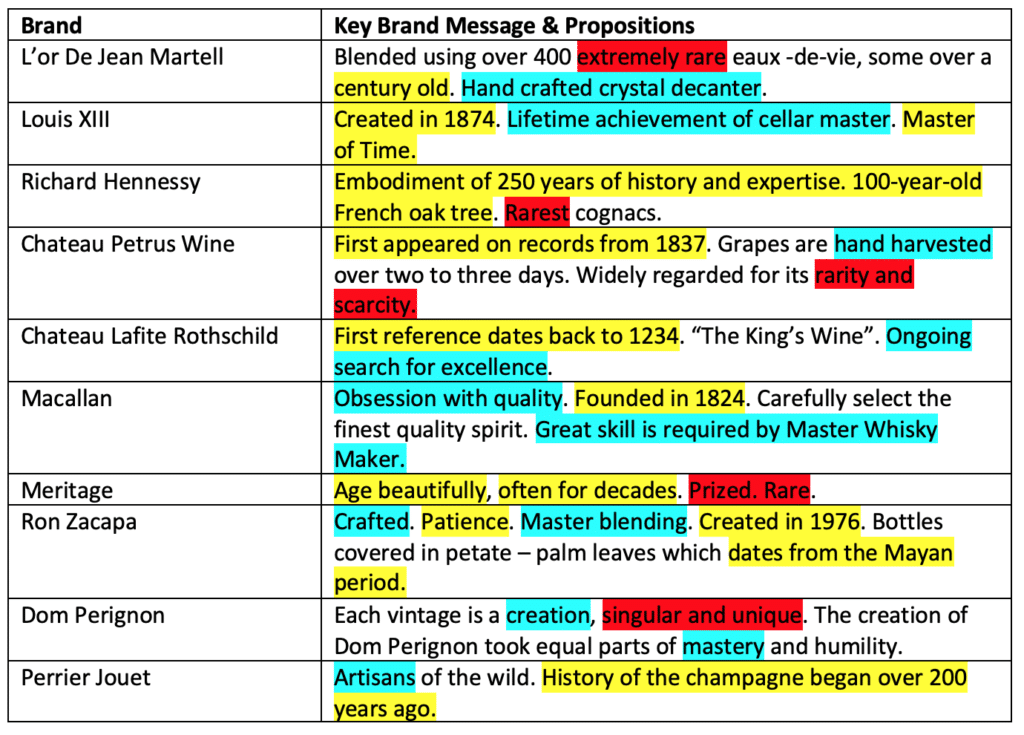
Finally, location and the use of hard-to-get ingredients are key brand messages from many luxury restaurants. Not surprisingly, Michelin star accreditations for their chefs are also critical elements that elevate these restaurants to luxury status.
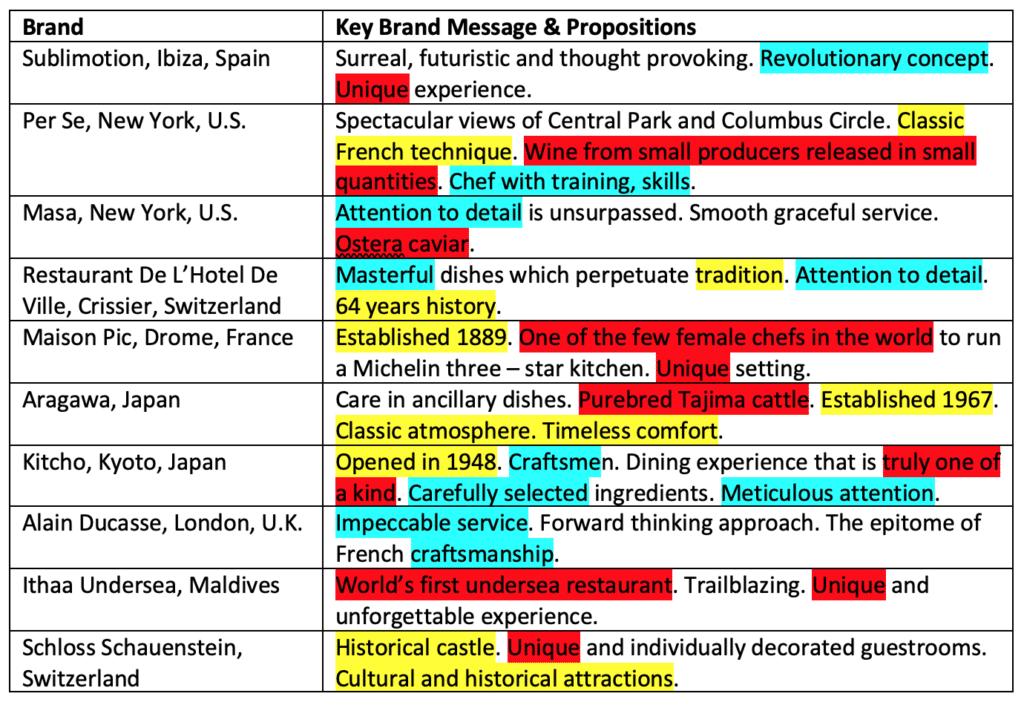
We observe that many of the brand propositions described above can be broadly classified into three thematic groups – (1) Time, (2) Rarity, and (3) Endeavor.
1. Time
Heritage, origin stories, lineage, legacies, necessary long aging processes, and the like fall into the category of “Time”. These “Time” related brand messages communicate propositions and qualities that cannot be earned overnight. Here, brand recognition and value have proven longevity and are able to stand the test of time. Users of the brand have the privilege of being associated with years of rich history. They believe little can go wrong with choosing a brand that has thrived in the market for so many years. These propositions that must be earned over time increase consumers’ value perception and desire for the brand.
2. Rarity
Many luxury brands also communicate propositions of uniqueness, exclusivity, hard-to-replicate locations, and raw materials that are difficult to procure. These can be grouped under the overarching theme of “Rarity”. Scarcity of supply is frequently an underlying reason elevating a brand to luxury status. As long as demand continues to outstrip supply, prices will be high, and not everyone who wants it will get it. It is accessible only to the selected few who can afford it. When such goods or services are being consumed publicly, it can bring attention to the privileged user. To those who like such attention, this further increases the value of the luxury brand.
3. Endeavor
Brand propositions such as craftsmanship, personalization, attention to detail, ensuring quality, and other values that depend on the mastery of a skill, hard work, and industry can be categorized under “Endeavor”. Consumers recognize and value the amount of effort to create a luxury product or service. This can be the effort that goes into personalizing the experience with the brand or the effort put into honing skills and techniques necessary for such creation. In consumers’ perception, “Endeavor” often translates directly to quality. Quality is frequently a key reason they are willing to pay substantially more for luxury goods or services.
While we should remain careful on insisting that our findings have universal applications, there is a clear consistency that many luxury brands do possess these three overarching qualities.
We conducted a second study to strengthen our findings from Study 1 further.
Study 2 – Interview
Study 2 collects data from primary sources to uncover qualities and propositions that consumers expect from a luxury brand.
As such, both Studies 1 and 2 are designed to help us determine key qualities, propositions, and thematic elements that luxury brands possess, but from two opposite angles: from the perspectives of the brands themselves (Study 1) and the perspectives of consumers (Study 2).
For Study 2, we engage student researchers through whom 97 interview respondents of differing profiles and nationalities are recruited. During the interviews, with participants split randomly across ten sessions, they are asked to share their views on what luxury means to them.
In 9 out of the 10 interview sessions, we managed to capture from their responses at least one of the three themes identified in Study 1. As such, Study 2 has provided further evidence that the three qualities of “Time, “Rarity” and “Endeavor” form the fundamentals of a brand’s luxury status. Regardless of whether the positioning comes from the brands themselves or consumers’ perceptions and expectations, these three thematic elements have been surfacing with a strong level of consistency.
From our findings in both Studies 1 and 2, we now have a clear, credible, and usable proposition depicting key elements that define luxury – “Time”, “Rarity” and “Endeavor”.
Our findings can be applied by brand managers in the luxury business with relative ease. We set out to achieve this from the beginning – to filter numerous definitions down to just a few consistent key words that capture the essence of most luxury brands.
Applying our Findings
Here are some ways brand managers incorporate these findings into their work.
- Luxury brand management can conduct an audit of all their marketing communications and identify the areas in their brand positioning that capture “Time”, “Rarity” and/or “Endeavor”. For example, their key messages may revolve around an intriguing origin story, limited production runs, or a manufacturing process that requires special skills. If this can be identified, it is of utmost importance that subsequent marketing communications do not lose sight of the key propositions that uphold luxury status for the brand. Suppose there is a documented set of brand identity guidelines. In that case, these propositions should also be included in the set, either in text, visual elements or both, to ensure consistency.
- Luxury brands are not spared the harsh realities of business. Like everyone else, they often need to meet shareholders’ expectations, which can lead to management pressure to increase production or reduce costs. An increase in production may help to increase revenue in the short term but eventually reduce the brand’s aura of rarity. Likewise, reducing costs may boost the bottom line but can hamper the brand’s endeavor to provide a high level of services. In these conflicting situations, management must stay aware of the key propositions that had elevated them to luxury status and thus the ability to charge higher prices. There should ideally be as little compromise on these areas as possible. Doing so may be akin to killing the goose that lays the golden eggs.
- The global luxury industry faces major transitions brought about by digital disruptions and growing consumer demands for sustainability. The need for changes accelerated with the onset of the Covid-19 pandemic. While many mass-market brands have been aggressively growing their online presence, the luxury segment is criticized by some quarters for being slow to act. They are “cautious about venturing into e-commerce because it doesn’t fit consumer expectations for a high-end shopping experience” (Willersdorf, Hazan, Ricci, Prénaud, Bianchi, Seara, and Yang, 2020). Likewise, efforts on environmental sustainability have been sporadic at best as doubts are being raised on whether there is such a thing as sustainable luxury. The top-end automotive segment makes an interesting case study in this aspect. While some brands have embraced electrification, others argue that there can never be a true luxury performance car without the roar of a traditional internal combustion engine. In our opinion, derived from this research, as long as luxury brand management stays consistent with their “Time”, “Rarity” and “Endeavor” propositions, they can be confident adopting online platforms and sustainability initiatives without compromising their luxury status. The principles of our findings can be implemented on both online and offline communication channels, and efforts on sustainability can enhance endeavoring perceptions of the brand.

About the Author: Dr. Victor Kwan
Dr. Victor Kwan has been in the automotive industry for over 20 years and is currently Managing Director for luxury brands such as Bentley, Aston Martin, and Bugatti in Southeast Asia. He has played key roles in building up brands across all market segments – from mass to premium to luxury, and has research interest in luxury brand management and word-of-mouth marketing on social media.

About the Author: Dr. Jimmy Wong
Prior to his academic career, Dr. Jimmy Wong worked for various corporations across different industries including FMCG, electronics, and pharmaceutical. His expertise in brand management was developed during his employment at companies such as Johnson & Johnson. After graduating with a Ph.D. in Consumer Psychology from the University of Illinois, he also lectured in different universities across the USA, Australia, and Singapore.




